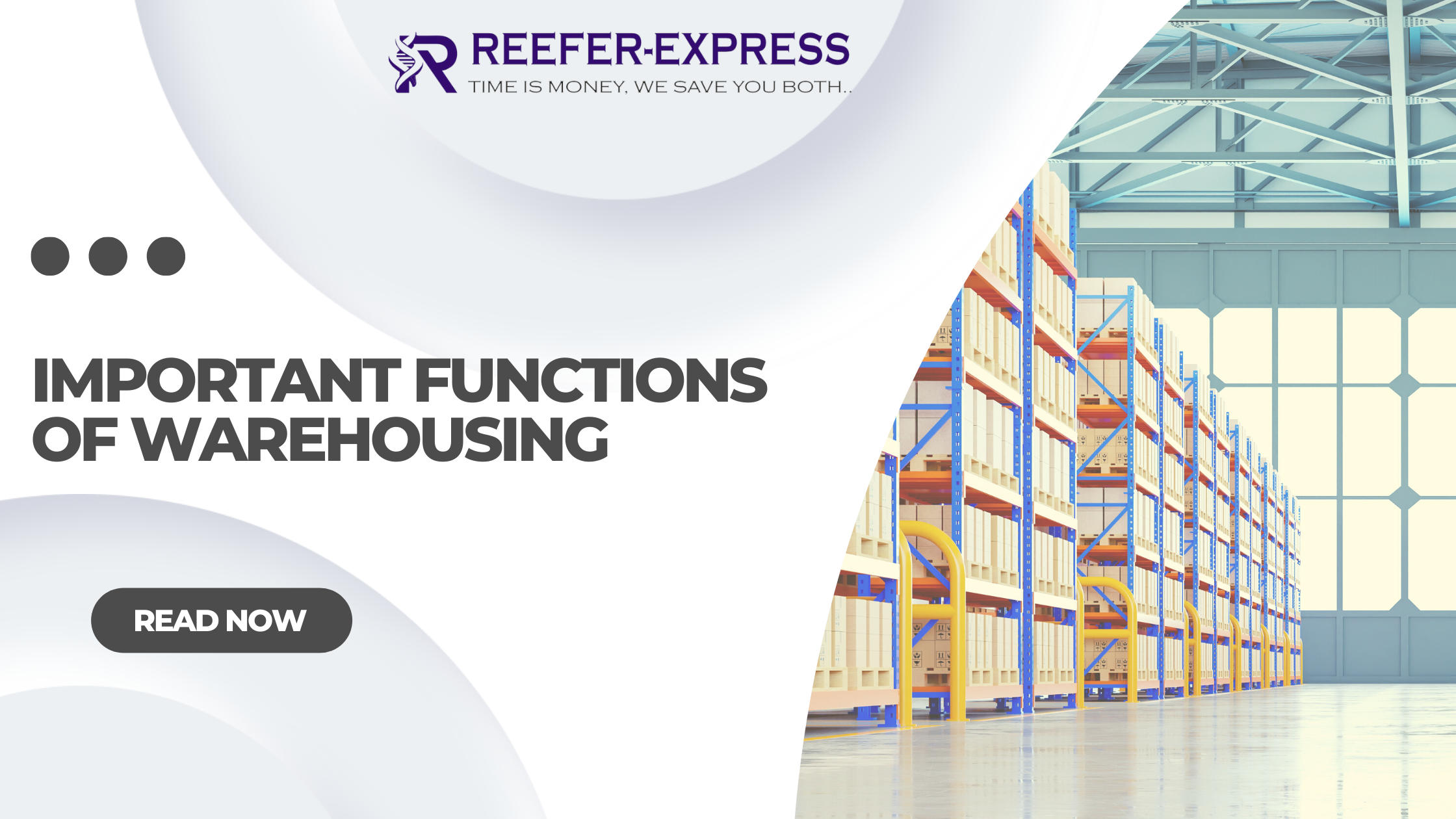Warehouse functions have changed dramatically since the early days of storage and distribution. Inbound logistics, order management, and outbound logistics must now be carried out in an environment that is far more complex and ever-changing than in the past. Nevertheless, certain core functions remain essential to the proper operation of any warehouse.
Warehouses can be considered the perfect spaces for storing goods and materials. They are used by nearly all categories of people, including manufacturers, wholesalers, and exporters to name a few. The warehouse is not just an area where we keep our excess inventory but also provides other useful features such as transport/customs services among others which makes it invaluable in today’s world!
What is Warehousing?
Warehousing is the process of storing goods and materials in a designated location. This can be done either on a temporary or permanent basis, depending on the needs of the business or individual. Warehousing is often used to store items that are in high demand or need to be protected from the elements.
Some businesses use warehousing as a way to free up space in their own facility. This can be done by renting out storage space from a third-party provider. This can be a more cost-effective option for businesses that do not have the space to store all of their inventory on-site.
Another reason why businesses use warehousing is to store inventory for future use. This can be helpful for businesses that do not have the room to keep all of their inventory on hand. It can also help businesses keep track of their inventory levels and ensure that they always have the right amount of product on hand.
Functions of Warehousing In Logistics:
1. Storage
Warehouses provide a place to store goods until they are needed. This is especially important for seasonal goods or goods that are not needed immediately.
There are two types of storage:
- Bulk storage: Goods are stored in large quantities. This is often used for commodities such as grain or coal.
- Unit storage: Goods are stored in smaller quantities and are often sorted by type, size, or destination.
2. Safeguarding of Goods
A warehouse can also provide security for goods, particularly valuable or delicate items that need to be protected from theft, vandalism or damage.
They are often equipped with security systems and fire protection to ensure the safety of the goods. Hence, a warehouse can provide a sense of security to businesses and consumers. Apart from this, some warehouses are also temperature-controlled to protect perishable goods from spoiling.
3. Handling of Goods
Warehouses are equipped with the necessary equipment to efficiently handle goods. This includes conveyor belts, forklifts, and other material-handling equipment. This is quite important as it helps to speed up the process of loading and unloading goods. Handling of goods involves all the activities from the time goods enter the warehouse till the time they are dispatched. These kind of inbound and outbound activities are very important in the warehousing process.
4. Transportation
Warehouses are often located near transportation hubs such as airports, seaports, and railroads. This allows for easy transportation of goods to and from the warehouse. Furthermore, many warehouses offer transportation services to their customers. This can be helpful for businesses that do not have their own transport fleet.
5. Value-Added Services
Value-added services are a great way to boost your company’s efficiency. They can help you optimize the supply chain and generate higher value, which means that customers will get their products faster! These types of service also include bundling up items for shipment or customizing them with extra features like personalization before sending them out into our stores -all while maintaining pristine condition at every step along the process
A few value-Added services involve:
- Packaging: Packaging helps to protect goods and makes them easier to transport.
- Labeling: Labeling provides information about the contents of the package.
- Assembly: Assembly is the process of putting together products that are sold in pieces. This is often done for large items such as furniture.
6. Information Management
Warehouses are a vital part of any company’s inventory management system. Not only do they store goods and materials sent into the warehouse, but also track information about who shipped them there as well as when it was picked up by someone else for shipment out again – this way you know what happened to all those packages!
7. Customer Service
Customer services are an important part of the warehousing process. They include activities such as order taking, invoicing, and returns processing. These services help to ensure that customers are satisfied with the products they receive.
The role of warehouses has evolved over the years, and they now play a vital role in the supply chain. They provide a place to store goods, protect them from damage, and distribute them to customers.
8. Financing
Warehousing can also help a company finance its inventory. This is because when a company borrows money from a lender, they often have to put up its inventory as collateral. If the company doesn’t have enough inventory to cover the loan, it may not be able to get the financing they need. However, if the company has access to a warehouse, it can use the inventory stored in the warehouse as collateral, which can help them get the financing they need.
Warehouse financing offers a number of advantages for borrowers, including the opportunity to use their raw materials and other goods as collateral. This type of loan typically provides more flexible terms than unsecured or short-term working capital loans due to its status as an asset-backed security (ABS). The cost associated with these types is cheaper compared to even secured versus non-collateralized lending options like personal guarantees which can be expensive depending on your credit score.
9. Market Research
Warehouses often conduct market research to study customer buying habits. This information is used to help companies make decisions about product assortment, pricing, and promotion. By understanding the patterns of goods flowing in and out of their facilities, warehouses can give companies valuable insights into consumer behavior which helps them to make more informed decisions about production, marketing, and distribution. This is especially useful for businesses that are looking to enter new markets or who are trying to optimize their existing supply chains.
10. Location
The location of a warehouse is an important factor in the efficiency of the supply chain. Warehouses are often located near population centers or transportation hubs to minimize transportation costs and time.
The above are some of the most important functions of warehousing. These functions are essential to the smooth operation of the supply chain and play a vital role in the movement of goods throughout the supply chain.
What Is The Importance Of Warehouse Management?
The importance of warehouse management has grown in recent years as companies have become more reliant on their supply chains to meet customer demand. A well-run warehouse is essential to the smooth operation of a company’s supply chain and can be the difference between meeting customer demand and losing sales.
An efficient warehouse operation can lead to lower inventory costs, shorter lead times, and improved customer satisfaction. In addition, a well-managed warehouse can provide a competitive advantage for a company by helping to ensure that products are available when and where they are needed.
Also Read- How To Use Cold Storage For Your Business
Factors To Consider When Managing A Warehouse
There are many factors to consider when managing a warehouse, such as store layout, inventory control, order fulfillment, and transportation. A good warehouse manager will have a strong understanding of all of these factors and how they interact with each other.
An effective warehouse management system (WMS) can help a company to optimize its warehouse operation and improve its bottom line. A WMS is a software application that helps to control and manage the movement of goods within a warehouse. The right WMS can help to increase efficiency, reduce costs, and improve customer service.
Benefits from Warehouses:
There are many benefits that a company can receive from having a warehouse, including:
- Reduced inventory costs: A warehouse can help to reduce the cost of inventory by providing a place to store goods until they are needed. This can help to avoid the need for expensive expedited shipping when demand is higher than expected.
- Improved customer service: A warehouse can help to improve customer service by ensuring that products are available when and where they are needed. This can help to avoid stockouts and backorders.
- Shorter lead times: A warehouse can help to shorten lead times by reducing the distance that goods need to travel. This can help to improve the efficiency of the supply chain and reduce transportation costs.
Type of Warehouses:
There are five main types of warehouses: distribution centers, manufacturing plants, retail stores, and storage facilities.
1. Distribution Centers: A distribution center is a type of warehouse that is used to store and distribute goods. Distribution centers are usually located near transportation hubs so that they can easily ship goods to their destinations.
2. Manufacturing Plants: A manufacturing plant warehouse is a type of industrial facility where raw materials and finished products are stored. These facilities are usually large in size and located near manufacturing plants or transportation hubs. Manufacturing plant warehouses are used to store a variety of items, including food, beverages, chemicals, machinery, and other manufactured goods.
3. Retail Stores: A retail store warehouse is a storage facility where retailers keep their products and inventory. These warehouses are usually located near the retailer’s stores so that the merchandise can be easily transported to the store locations. Retail store warehouses may also be used to store seasonal items or excess inventory.
4. Storage Facilities: These Warehouses are used by manufacturers, and imports are being used. Storage facilities are usually located near transportation hubs so that they can easily ship goods to their destinations.
5. On-demand storage: On-demand storage systems are those that can be accessed and utilized as needed, providing a high level of flexibility and convenience. These systems are often used in environments where space is at a premium, such as in-office buildings or retail stores. On-demand storage systems can be either physical or virtual.
6. Bonded Warehouse: A bonded warehouse is a type of warehouse that is used to store and distribute goods that are subject to import duties. Bonded warehouses are usually located near ports so that they can easily ship goods to their destinations.
Why Choose Reefer Express for Cold Chain Solutions
Reefer Express is a proud provider of warehousing functions for clients across India. We offer an array of cold chain services that allow our customers to focus on their business, while we take care of their storage and distribution needs. Our warehouses are located in strategic locations across the country, which allows us to serve clients in all major markets. You can contact us to learn more about our warehousing functions and how we can help you streamline your business.






